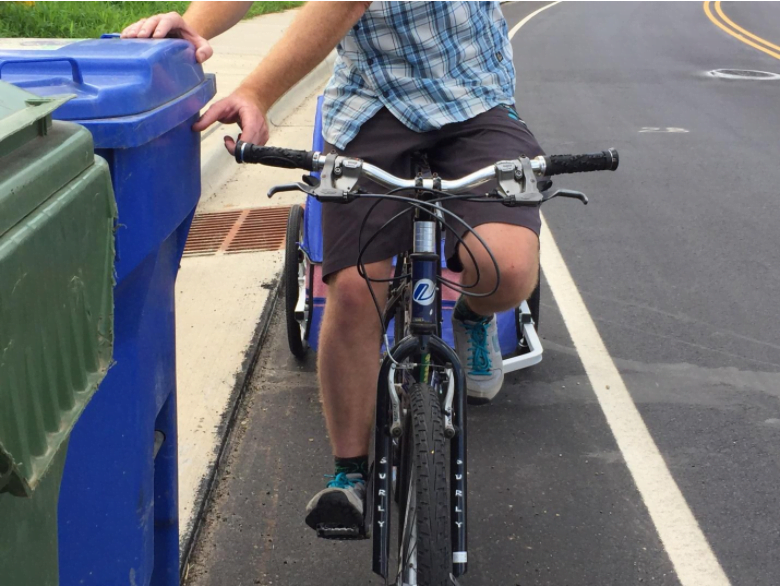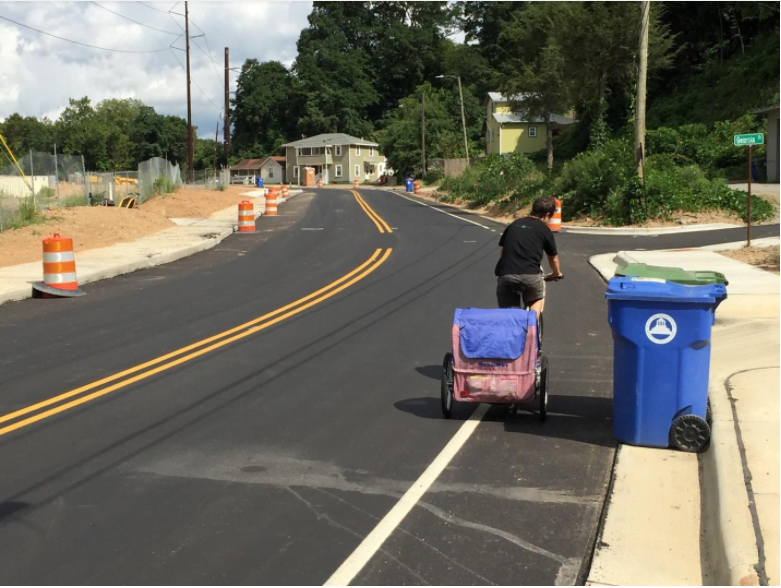
August 15, 2015
Asheville Transportation Department
City Hall, Mezzanine Level
70 Court Plaza
Asheville, NC 28801
City of Asheville of Asheville Transportation Department,
The current condition of Craven St. has afforded the opportunity to evaluate the potential function of the bike lane on the route before the final asphalt is put into place. Once completed, Craven St. will serve as a major bicycle thoroughfare for our community as it will connect West Asheville to greenways, and will become an attraction for surrounding residents and tourists alike. Craven St. will be a critical bicycle connector once the future greenway is complete and the New Belgium Brewery opens.
Since there is no direct connection from the greenway to the brewery site, bicyclists are required to use the bike lanes along the new Craven Street section. Also, several families will access Craven St. from Waynesville to connect with either the greenway, Clingman or Haywood. Many of these cyclists are likely to be families or people who are not used to riding on roads. We need to build bicycle infrastructure that works for all people on bikes. We hope these factors are considered in what we suggest the city consider below.
This past weekend a few neighbors and I took bicycles with trailers affixed to them to illustrate how a 4-foot bike lane may not be the safest condition for the bicyclists described above. Please review the pictures below as they clearly show that a 4-foot bike lane does not provide adequate space for safe riding.

Picture 2: The people working on the Craven Street project were very careful in measuring the lane widths north of Waynesville Avenue. To the south of Waynesville this not the case. The bike lane through this section is not 4 feet wide as called for in the engineering documents. This creates a more hazardous condition for bicyclists with trailers or panniers, cargo-bikes, and recumbents.
Even if the roadway was flush with the gutter, placing the right-side tire of the trailer in the gutter is not a suitable riding position for the bicyclist as it creates a different surface and potentially different slopes for the bicyclist to navigate.

Picture 3: In November, the City presented a PowerPoint on the Craven St. improvements which included a 6.5-foot bicycle lane on the west side of Craven St. (page 5: Craven St Improvement). Although I recognize they were innocent mistakes, the cross-section slide included two errors: 1) It counted the raised curb in this calculation; and 2) It counted the gutter as bikeable space. While I acknowledge the City of Asheville 2008 Bicycle Plan includes the gutter as usable space, since then, NCDOT’s 2012 Complete Streets Guidelines stipulate the gutter is not counted as usable space when measuring a bike lane’s width. The City of Asheville needs to be building bicycle infrastructure to the higher standards so that they work of all people and not just the die-hard cyclist.

Picture 4 illustrates why we feel the gutter cannot be counted as usable space. Even before project completion, trash and recycling bins are being placed in the curb, requiring a cyclist to veer outside the lane and into the car’s lane. Cyclists require adequate space to ride safely and predictably.

Picture 5 shows the limited margin for error cyclists have when trying to stay within the bike lane and passing the bins. This will happen at least one out of every 7 days and, as we see here, property owners usually put their bins out to curb one day before pickup is to occur.

In order to implement bicycle infrastructure that works for all the people who choose to ride Craven St, Asheville on Bikes requests the following:
- The city consider a 5-foot-wide bike lane on the southbound side of Craven Street when the top surface of asphalt is completed. This would not constitute an additional cost to the project but would be a slight change in how the bike lanes are measured. While we realize there are trucks on this route, we are confident New Belgium can work with their drivers to promote a safe operating speed in the short section they would be required to operate in a 10-foot travel lane.
- The city work closely with the contractor as the final lanes are put in place. As we see on the new section, the contractors did not follow the design plans in ensuring the bike lane was the width called for in the engineering documents.
- If a 5-foot bike lane is not acceptable, we request the city consider a one-foot wide cross-hatched buffer on the outside of the 4-foot southbound bike lane. This creates a visible space on which trucks and motorists should not encroach. The 10 feet of open space in the lane for cars is more than adequate. The one-foot buffer would allow trucks some margin of error and we trust they will be cautious when overtaking a bicyclist who is riding in the bike lane.
I’d be more than happy to meet with any or all of you on Craven St to review the current issues with the 4-foot bike lane. If you have any follow up questions or comments, please don’t hesitate to contact me.
Respectfully,
Mike Sule
Asheville on Bikes